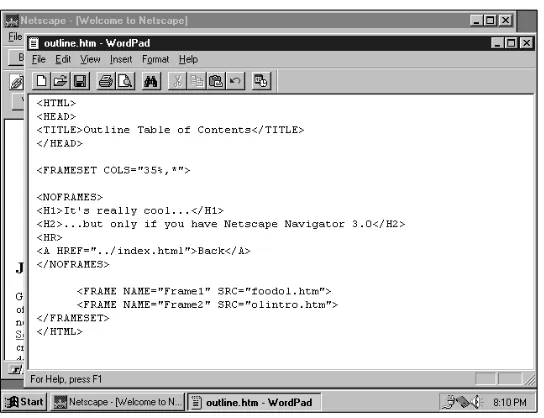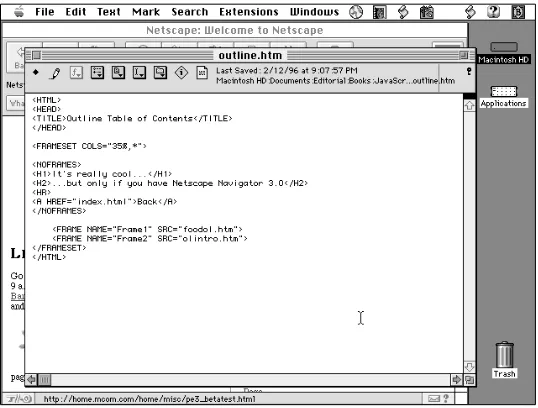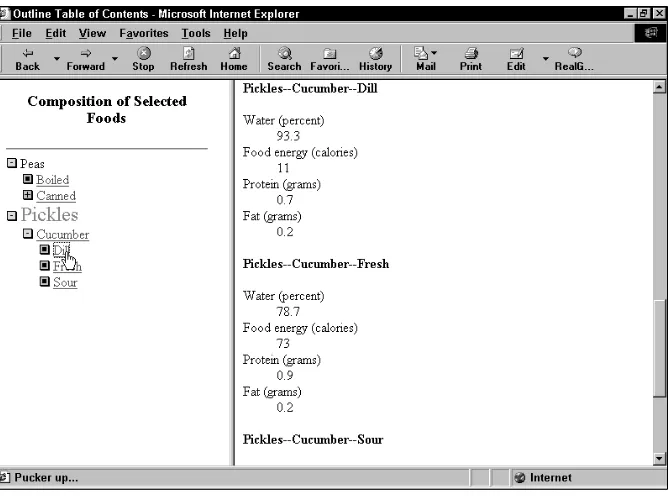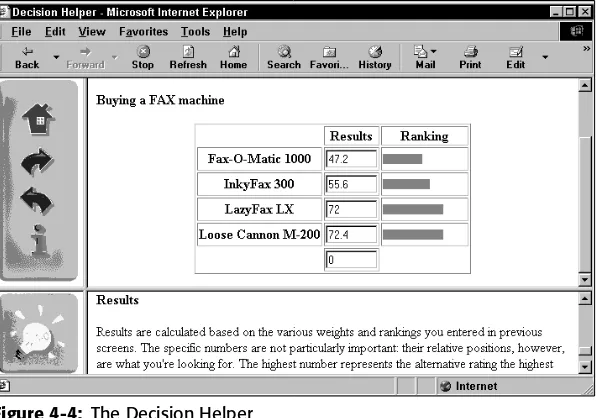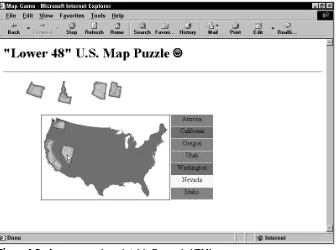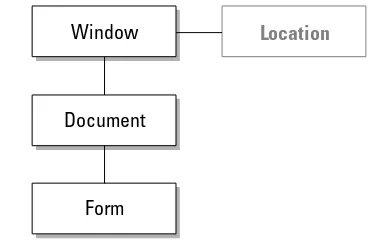Bible
Advance
your JavaScript
skills with the most
comprehensive resource
available
Conquer
high-end
scripting challenges using
the latest techniques
Optimize scripts for
Internet Explorer 5.5
and Netscape Navigator 6
ible
CD-ROM
INSIDE!
Nearly 300 Ready-to-Run
Example Scripts and More
on CD-ROM!
J
ava
S
cript
J
ava
S
cript
The Definitive
JavaScript Guide
— Over 175,000
Copies in Print
Danny Goodman
JavaScript pioneer and Consultant®
With a foreword by Brendan Eich, creator of JavaScript
®
Features 15
bonus chapters
“JavaScript Bibleis the definitive resource in JavaScript programming. I am never more than three feet from my copy.”
— Steve Reich, CEO, PageCoders
“This book is a must-have for any Web developer or programmer.” — Thoma Lile, President, Kanis Technologies, Inc.
“Outstanding book. I would recommend this book to anyone interested in learning to develop advanced Web sites. Mr. Goodman did an excellent job of organizing this book and writing it so that even a beginning programmer can understand it.”
— Jason Hensley, Director of Internet Services, NetVoice, Inc.
“Goodman is always great at delivering clear and concise technical books!” — Dwayne King, Chief Technology Officer, White Horse
“JavaScript Bibleis well worth the money spent!”
— Yen C.Y. Leong, IT Director, Moo Mooltimedia, a member of SmartTransact Group
“A must-have book for any Internet developer.” — Uri Fremder, Senior Consultant, TopTier Software
“I love this book! I use it all the time, and it always delivers. It’s the only JavaScript book I use!”
— Jason Badger, Web Developer
“Whether you are a professional or a beginner, this is a great book to get.” — Brant Mutch, Web Application Developer, Wells Fargo Card Services, Inc.
“I never thought I’d ever teach programming before reading your book [JavaScript Bible]. It’s so simple to use — the Programming Fundamentals section brought it all back! Thank you for such a wonderful book, and for breaking through my program-ming block!”
— Susan Sann Mahon, Certified Lotus Instructor, TechNet Training
“I continue to get so much benefit from JavaScript Bible. What an amazing book! Danny Goodman is the greatest!”
— Patrick Moss
“Danny Goodman is very good at leading the reader into the subject. JavaScript Bible has everything we could possibly need.”
“I continue to use the book on a daily basis and would be lost without it.” — Mike Warner, Founder, Oak Place Productions
“JavaScript Bibleis by farthe best JavaScript resource I’ve ever seen (and I’ve seen quite a few).”
JavaScript
Bible,
Gold Edition
Danny Goodman
With a foreword by Brendan Eich, creator of JavaScript
Best-Selling Books • Digital Downloads • e-Books • Answer Networks • e-Newsletters • Branded Web Sites • e-Learning
New York, NY 10022 www.hungryminds.com
Copyright © 2001 Danny Goodman. All rights reserved. No part of this book, including interior design, cover design, and icons, may be reproduced or transmitted in any form, by any means (electronic, photocopying, recording, or otherwise) without the prior written permission of the publisher.
Library of Congress Control Number: 2001090713 ISBN: 0-7645-4718-6
Printed in the United States of America 10 9 8 7 6 5 4 3 2 1
1P/RV/QW/QR/IN
Distributed in the United States by Hungry Minds, Inc. Distributed by CDG Books Canada Inc. for Canada; by Transworld Publishers Limited in the United Kingdom; by IDG Norge Books for Norway; by IDG Sweden Books for Sweden; by IDG Books Australia Publishing Corporation Pty. Ltd. for Australia and New Zealand; by TransQuest Publishers Pte Ltd. for Singapore, Malaysia, Thailand, Indonesia, and Hong Kong; by Gotop Information Inc. for Taiwan; by ICG Muse, Inc. for Japan; by Intersoft for South Africa; by Eyrolles for France; by International Thomson Publishing for Germany, Austria, and Switzerland; by Distribuidora Cuspide for Argentina; by LR
International for Brazil; by Galileo Libros for Chile; by Ediciones ZETA S.C.R. Ltda. for Peru; by WS Computer Publishing Corporation, Inc., for the Philippines; by
Mexico; by Editorial Norma de Panama S.A. for Panama; by American Bookshops for Finland. For general information on Hungry Minds’ products and services please contact our Customer Care department; within the U.S. at 800-762-2974, outside the U.S. at 317-572-3993 or fax 317-572-4002. For sales inquiries and resellers information, including discounts, premium and bulk quantity sales and foreign language translations please contact our Customer Care department at 800-434-3422, fax 317-572-4002 or write to Hungry Minds, Inc., Attn: Customer Care department, 10475 Crosspoint Boulevard, Indianapolis, IN 46256.
For information on licensing foreign or domestic rights, please contact our Sub-Rights Customer Care department at 212-884-5000.
For information on using Hungry Minds’ products and services in the classroom or for ordering examination copies, please contact our Educational Sales department at 800-434-2086 or fax 317-572-4005. For press review copies, author interviews, or other publicity information, please contact our Public Relations department at 317-572-3168 or fax 317-572-4168.
For authorization to photocopy items for corporate, personal, or educational use, please contact Copyright Clearance Center, 222 Rosewood Drive, Danvers, MA 01923, or fax 978-750-4470.
LIMIT OF LIABILITY/DISCLAIMER OF WARRANTY: THE PUBLISHER AND AUTHOR HAVE USED THEIR BEST EFFORTS IN PREPARING THIS BOOK. THE PUBLISHER AND AUTHOR MAKE NO
REPRESENTATIONS OR WARRANTIES WITH RESPECT TO THE ACCURACY OR COMPLETENESS OF THE CONTENTS OF THIS BOOK AND SPECIFICALLY DISCLAIM ANY IMPLIED WARRANTIES OF
MERCHANTABILITY OR FITNESS FOR A PARTICULAR PURPOSE. THERE ARE NO WARRANTIES WHICH EXTEND BEYOND THE DESCRIPTIONS CONTAINED IN THIS PARAGRAPH. NO WARRANTY MAY BE CREATED OR EXTENDED BY SALES REPRESENTATIVES OR WRITTEN SALES MATERIALS. THE ACCURACY AND COMPLETENESS OF THE INFORMATION PROVIDED HEREIN AND THE OPINIONS STATED HEREIN ARE NOT GUARANTEED OR WARRANTED TO PRODUCE ANY PARTICULAR RESULTS, AND THE ADVICE AND STRATEGIES CONTAINED HEREIN MAY NOT BE SUITABLE FOR EVERY
INDIVIDUAL. NEITHER THE PUBLISHER NOR AUTHOR SHALL BE LIABLE FOR ANY LOSS OF PROFIT OR ANY OTHER COMMERCIAL DAMAGES, INCLUDING BUT NOT LIMITED TO SPECIAL, INCIDENTAL, CONSEQUENTIAL, OR OTHER DAMAGES.
Trademarks:JavaScript is a registered trademark or trademark of Sun Microsystems, Inc. All other trademarks are property of their respective owners. Hungry Minds, Inc. is not associated with any product or vendor mentioned in this book.
Danny Goodman
Acquisitions Editor
Debra Williams Cauley
Project Editor
Neil Romanosky
Technical Editor
David Wall
Copy Editors
Jerelind Charles
Victoria Lee O’Malley
Proof Editor
Cordelia Heaney
Editorial Manager
Colleen Totz
Project Coordinators
Cindy Phipps
Regina Snyder
Graphics and Production Specialists
Sean Decker
John Greenough
LeAndra Johnson
Stephanie Johnson
Gabriele McCann
Jill Piscitelli
Heather Pope
Ron Terry
Erin Zeltner
Quality Control Technicians
Laura Albert
Joel Draper
Andy Hollandbeck
Susan Moritz
Permissions Editor
Laura Moss
Media Development Specialist
Greg Stephens
Media Development Coordinator
Marisa Pearman
Book Designer
Kurt Krames
Proofreading
TECHBOOKS Production Services
Indexer
Johnna VanHoose Dinse
Foreword
A
s JavaScript’s creator, I would like to say a few words about where JavaScript
has been, where it is going, and how the book you’re holding will help you to
make the most of the language.
JavaScript was born out of a desire to let HTML authors write scripts directly in their
documents. This may seem obvious now, but in the spring of 1995 it was novel and
more than a little at odds with both the conventional wisdom (that HTML should
describe static document structure only) and the Next Big Thing (Java applets, which
were hyped as the one true way to enliven and extend Web pages). Once I got past
these contentions, JavaScript quickly shaped up along the following lines:
✦
“Java-lite” syntax.
Although the “natural language” syntax of HyperTalk was fresh
in my mind after a friend lent me The Complete HyperCard Handbook
by some fellow
named Goodman, the Next Big Thing weighed heavier, especially in light of another
goal: scripting Java applets. If the scripting language resembled Java, then those
pro-grammers who made the jump from JavaScript to Java would welcome similarities in
syntax. But insisting on Java’s class and type declarations, or on a semicolon after
each statement when a line ending would do, was out of the question — scripting for
most people is about writing short snippets of code, quickly and without fuss.
✦
Events for HTML elements.
Buttons should have
onClickevent handlers.
Documents load and unload from windows, so windows should have onLoad and
onUnload handlers. Users and scripts submit forms: thus the onSubmit handler.
Although not initially as flexible as HyperCard’s messages (whose handlers inspired
the onEvent naming convention), JavaScript events let HTML authors take control
of user interaction from remote servers and respond quickly to user gestures and
browser actions. With the adoption of the W3C DOM Level 2 event handling
recom-mendations, JavaScript in modern browsers has fully flexible control over events.
✦
Objects without classes.
The Self programming language proved the notion of
prototype-based inheritance. For JavaScript, I wanted a single prototype per object
(for simplicity and efficiency), based by default on the function called using the new
operator (for consonance with Java). To avoid distinguishing constructors from
methods from functions, all functions receive the object naming them as the
prop-erty that was called, in the
thisparameter. Although prototypes didn’t appear until
Navigator 3, they were prefigured in Version 2 by quoted text being treated as an
object (the String object prototype, to which users could attach methods).
At first, I thought JavaScript would most often find use in validating input to HTML
forms. But before long, I was surprised to see how many Web designers devised
compelling applications by way of script-generated HTML and JavaScript objects. It
became clear from user demonstration and feedback that Web designers sought to
build significant applications quickly and effectively with just a few images, HTML,
and JavaScript. Eventually they demanded that the browser support what is now
known as “Dynamic HTML” (one fun link:
http://www.javascript-games.org/).
As legions of Web authors embraced the authoring power of JavaScript, they, in turn,
demonstrated the crucial advantages of a scripting environment over old-school
application development. Not only were the HTML and JavaScript languages
com-paratively easy to use, but development did not require the programming expertise
needed to light all pixels and handle all events as in a big, traditional application.
The primacy of JavaScript on the Web today vindicates our early belief in the value
of a scripting language for HTML authors. By keeping the “pixel-lighting” bar low,
HTML with images has made Web designers out of millions of people. By keeping
the “event-handling” bar low, JavaScript has helped many thousands of those
designers become programmers. Perhaps the ultimate example of Web
develop-ment’s convergence with application development is the Mozilla browser, wherein
all of the user-interface and even some custom widgets and modular components
are implemented entirely using JavaScript, Cascading Style Sheets (CSS), custom
XML-based markup languages, and images.
JavaScript is also a general language, useful apart from HTML and XML. It has been
embedded in servers, authoring tools, browser plug-ins, and other kinds of browsers
(for such things as 3D graphical worlds). Its international standard, ECMA-262 (ISO
16262), has advanced to a Third Edition. But compared with languages such as Perl
and even Java, it is still relatively young. Work toward a Fourth Edition of the
lan-guage, supporting optional types, classes, and versioning facilities, progresses
within the ECMA technical committee (see the “JS2” proposal to the ECMA technical
committee documented at
http://www.mozilla.org/js/language/js20/).
It is clear to me that JavaScript would not have survived without a creative, loyal,
and patient community of developers; I owe them each a huge debt of thanks.
Those developers who took up the beta releases of Navigator 2 and disseminated
vital workarounds and feature requests by e-mail and net-news are the language’s
godparents. Developer support and feedback continue to make JavaScript the
eclectic, rambunctious success it is.
The book in your hands compiles thousands of those “developer miles” with the
insight of an expert guide and teacher. Danny didn’t know at the time how much
inspi-ration I found in his HyperCard book, but it was on my desk throughout the
develop-ment of JavaScript in 1995. His energy, compassion, and clear prose helped me keep the
goal of “a language for all” in mind. It is enormously gratifying to write the foreword to
the Gold edition of this book, which has earned so many “satisfied reader miles.”
I highly recommend Danny Goodman’s JavaScript Bible
to anyone who wants to
learn JavaScript, and especially to those HTML authors who’ve so far written only a
few scripts or programs — you’re in for a lifetime of fun on the “scripting road” with
a trusty guide at your side.
Preface
F
or nearly 20 years, I have written the books I wished had already been written
to help me learn or use a new technology. Whenever possible, I like to get in at
the very beginning of a new authoring or programming environment, feel the
grow-ing pains, and share with readers the solutions to my struggles. This Gold edition of
the JavaScript Bible
represents knowledge and experience accumulated over five
years of daily work in JavaScript and a constant monitoring of newsgroups for
ques-tions, problems, and challenges facing scripters at all levels. My goal is to help you
avoid the same frustration and head scratching I and others have experienced
through multiple generations of scriptable browsers.
While previous editions of this book focused on the then-predominant Netscape
Navigator browser, the swing of the browser market share pendulum currently
favors Microsoft Internet Explorer. At the same time, Netscape has accomplished
the admirable task of reinventing its own browser in light of rapidly advancing
industry standards. As a result of both of these trends, this massively revised and
expanded Gold edition treats both brands of browsers as equals as far as scripters
are concerned. You hear my praise and dismay at various scripting features of both
browser families. But empowering you to design and write good scripts is my
pas-sion, regardless of browser. Therefore, the book contains details about proprietary
and standard implementations to equip you to choose the development path that
best fits your content’s audience. If you detect any bias of mine throughout this
book, it is a desire, where possible, to write scripts that work on as many browsers
as possible.
Organization and Features of This Edition
Because of the greatly expanded range of vocabularies that scripts may use in the
latest browser versions, the biggest change to the structure of the book is in the
ref-erence portion. In this edition, you find a greater distinction between the document
object model and core JavaScript language reference sections. This new division
should help those readers who are primarily interested in only the JavaScript
lan-guage (for use in other applications) find what they need more quickly. Here are
some details about the book’s structure.
Part I
arrived on the scene. That’s why Chapter 2 is devoted to addressing challenges
fac-ing scripters who must develop applications for both sfac-ingle- and cross-platform
browser audiences amid rapidly changing standards efforts. Chapter 3 provides the
first foray into JavaScript, where you get to write your first practical script.
Part II
All of Part II is handed over to a tutorial for newcomers to JavaScript. Nine lessons
provide you with a gradual path through browser internals, basic programming
skills, and genuine JavaScript scripting. With only a couple of clearly labeled items,
the lessons cover scripting topics that apply to all scriptable browsers. Exercises
fol-low at the end of each lesson to help reinforce what you just learned and challenge
you to use your new knowledge (you’ll find answers to the exercises in Appendix C).
The goal of the tutorial is to equip you with sufficient experience to start scripting
simple pages right away while making it easier for you to understand the in-depth
discussions and examples in the rest of the book. By the end of the final lesson,
you’ll know how to script multiple frame environments and even create the
mouse-rollover image swapping effect that is popular in a lot of Web pages these days.
You can find all of the Part II chapters on the CD-ROM that accompanies this book.
Part III
Part III, the largest section of the book, provides in-depth coverage of the document
object models as implemented in browsers from the earliest days to today. In all
ref-erence chapters, a compatibility chart indicates the browser version that supports
each object and object feature. One chapter in particular, Chapter 15, contains
ref-erence material that is shared by most of the remaining chapters of Part III. To help
you refer back to Chapter 15 from other chapters, a dark tab along the outside edge
of the page shows you at a glance where the chapter is located. Additional
naviga-tion aids include guide words at the bottoms of most pages to indicate which object
and object feature is covered on the page.
Part IV
Reference information for the core JavaScript language fills Part IV. As with
refer-ence chapters of Part III, the JavaScript chapters display browser compatibility
charts for every JavaScript language term. Guide words at the bottoms of pages
help you find a particular term quickly.
Part V
In Part V, I get down to the business of deploying JavaScript. Here are the practical
aspects of JavaScript, such as Chapter 43’s coverage of client-side form data
valida-tion and Chapter 44’s coverage of blending Java applets and plug-ins into pages.
On theDebugging scripts is the focus of Chapter 45, with tips on understanding error
messages, building your own debugging tools. Chapter 46 goes into great detail
about security issues for JavaScript-enabled applications. Dynamic HTML in a
cross-browser environment is the subject of Chapter 47, while Chapter 48 introduces you
to Microsoft’s behaviors mechanism for Windows.
The remaining nine chapters consist of full-fledged applications of JavaScript. These
applications are designed not necessarily as plug-and-play modules you can put into
your pages right away. Instead, their goal is to demonstrate many of the concepts
described earlier in the book by way of real-world examples. New for this edition are
some examples based on XML data islands in Internet Explorer for Windows.
Part VI
Finally, several appendixes at the end of the book provide helpful reference
informa-tion. These resources include a JavaScript and Browser Objects Quick Reference in
Appendix A, a list of JavaScript reserved words in Appendix B, answers to Part II’s
tutorial exercises in Appendix C, and Internet resources in Appendix D. In Appendix E,
you also find information on using the CD-ROM that comes with this book.
CD-ROM
The accompanying CD-ROM contains over 300 ready-to-run HTML documents that
serve as examples of most of the document object model and JavaScript
vocabu-lary words in Parts III and IV. You can run these examples with your
JavaScript-enabled browser, but be sure to use the
index.htmlpage in the listings folder as a
gateway to running the listings. This page shows you the browsers that are
compat-ible with each example listing. I could have provided you with humorous little
sam-ple code fragments out of context, but I think that seeing full-fledged HTML
documents (simple though they may be) for employing these concepts is
impor-tant. I intentionally omitted the script listings from the tutorial part (Part II) of this
book to encourage you to type the scripts. I believe you learn a lot, even by aping
listings from the book, as you get used to the rhythms of typing scripts in
docu-ments. You also find listings from Parts I and V on the CD-ROM.
The CD-ROM holds another valuable resource: dozens and dozens of Example
sec-tions for Parts III and IV, which are compiled in Appendix F. Many of these secsec-tions
reveal detailed descriptions of HTML listings that illustrate a particular object
model or language feature. Even more Example sections invite you to try out an
object model or language feature with the help of an interactive workbench, called
The Evaluator — a JavaScript Bible
exclusive! You see instant results and quickly
learn how the feature works.
Prerequisites to Learning JavaScript
Although this book doesn’t demand that you have a great deal of programming
experience behind you, the more Web pages you’ve created with HTML, the easier
you will find it to understand how JavaScript interacts with the familiar elements
you normally place in your pages. Occasionally, you will need to modify HTML tags
to take advantage of scripting. If you are familiar with those tags already, the
JavaScript enhancements will be simple to digest.
Forms and their elements (text fields, buttons, and selection lists) play an
espe-cially important role in much of typical JavaScript work. You should be familiar with
these elements and their HTML attributes. Fortunately, you won’t need to know
about server scripting or passing information from a form to a server. The focus
here is on client-side scripting, which operates independently of the server after
the JavaScript-enhanced HTML page is fully loaded into the browser.
The basic vocabulary of the current HTML standard should be part of your working
knowledge. When we get to using frames, for instance, the focus is on how to script
these elements, not on designing pages with them. Microsoft, Netscape, and other
online sources provide more detailed explanations of frames.
If you’ve never programmed before
To someone who learned HTML from a slim guidebook a few years ago, the size of
this book must be daunting. JavaScript may not be the easiest language in the
world to learn, but believe me, it’s a far cry from having to learn a full programming
language, such as Java or C. Unlike developing a full-fledged monolithic application
(such as the productivity programs you buy in the stores), JavaScript lets you
experiment by writing small snippets of program code to accomplish big things.
The JavaScript interpreter built into every scriptable browser does a great deal of
the technical work for you.
Programming, at its most basic level, consists of nothing more than writing a series of
instructions for the computer to follow. We humans follow instructions all the time,
even if we don’t realize it. Traveling to a friend’s house is a sequence of small
tions: Go three blocks that way; turn left here; turn right there. Amid these
instruc-tions are some decisions that we have to make: If the stoplight is red, then stop; if the
light is green, then go; if the light is yellow, then floor it. Occasionally, we must repeat
some operations several times (kind of like having to go around the block until a
parking space opens up). A computer program not only contains the main sequence
of steps, but it also anticipates what decisions or repetitions may be needed to
accomplish the program’s goal (such as how to handle the various states of a
stop-light or what to do if someone just stole the parking spot you were aiming for).
communicate with them in the specific language they understand. When speaking
to another human, you can flub a sentence’s syntax and still have a good chance of
the other person’s understanding you fully. Not so with computer programming
lan-guages. If the syntax isn’t perfect (or at least within the language’s range of
knowl-edge that it can correct), the computer has the brazenness to tell you that you have
made a syntax error.
The best thing you can do is to just chalk up the syntax errors you receive as
learn-ing experiences. Even experienced programmers get them. Every syntax error you
get — and every resolution of that error made by rewriting the wayward
statement — adds to your knowledge of the language.
If you’ve done a little programming before
Programming experience in a procedural language, such as BASIC or Pascal, may
almost be a hindrance rather than a help to learning JavaScript. Although you may
have an appreciation for precision in syntax, the overall concept of how a program
fits into the world is probably radically different from how JavaScript works. Part of
this has to do with the typical tasks a script performs (carrying out a very specific
task in response to user action within a Web page), but a large part also has to do
with the nature of object-oriented programming.
In a typical procedural program, the programmer is responsible for everything that
appears on the screen and everything that happens under the hood. When the
pro-gram first runs, a great deal of code is dedicated to setting up the visual
environ-ment. Perhaps the screen contains several text entry fields or clickable buttons. To
determine which button a user clicks, the program examines the coordinates of the
click and compares those coordinates against a list of all button coordinates on the
screen. Program execution then branches out to perform the instructions reserved
for clicking in that space.
Object-oriented programming is almost the inverse of that process. A button is
con-sidered an object — something tangible. An object has properties, such as its label,
size, alignment, and so on. An object may also contain a script. At the same time, the
system software and browser, working together, can send a message to an object —
depending on what the user does — to trigger the script. For example, if a user clicks
in a text entry field, the system/browser tells the field that somebody has clicked
there (that is, has set the focus to that field), giving the field the task of deciding
what to do about it. That’s where the script comes in. The script is connected to the
field, and it contains the instructions that the field carries out after the user
acti-vates it. Another set of instructions may control what happens when the user types
an entry and tabs or clicks out of the field, thereby changing the content of the field.
Making the transition from procedural to object-oriented programming may be the
most difficult challenge for you. When I was first introduced to object-oriented
pro-gramming a number of years ago, I didn’t get it at first. But when the concept
clicked — a long, pensive walk helped — so many light bulbs went on inside my
head that I thought I might glow in the dark. From then on, object orientation
seemed to be the only sensible way to program.
If you’ve programmed in C before
By borrowing syntax from Java (which, in turn, is derived from C and C++), JavaScript
shares many syntactical characteristics with C. Programmers familiar with C will feel
right at home. Operator symbols, conditional structures, and repeat loops follow very
much in the C tradition. You will be less concerned about data types in JavaScript than
you are in C. In JavaScript, a variable is not restricted to any particular data type.
With so much of JavaScript’s syntax familiar to you, you will be able to concentrate
on document object model concepts, which may be entirely new to you. You will
still need a good grounding in HTML (especially form elements) to put your
exper-tise to work in JavaScript.
If you’ve programmed in Java before
Despite the similarity in their names, the two languages share only surface aspects:
loop and conditional constructions, C-like “dot” object references, curly braces for
grouping statements, several keywords, and a few other attributes. Variable
decla-rations, however, are quite different, because JavaScript is a loosely typed
lan-guage. A variable can contain an integer value in one statement and a string in the
next (though I’m not saying that this is good style). What Java refers to as methods,
JavaScript calls methods (when associated with a predefined object) or functions
(for scripter-defined actions). JavaScript methods and functions may return values
of any type without having to state the data type ahead of time.
Perhaps the most important aspects of Java to suppress when writing JavaScript are
the object-oriented notions of classes, inheritance, instantiation, and message
pass-ing. These aspects are simply non-issues when scriptpass-ing. At the same time, however,
JavaScript’s designers knew that you’d have some hard-to-break habits. For example,
although JavaScript does not require a semicolon at the end of each statement line,
if you type one in your JavaScript source code, the JavaScript interpreter won’t balk.
If you’ve written scripts (or macros) before
More sophisticated scripting, such as that found in Toolbook or HyperCard,
pre-pares you for the object orientation of JavaScript. In those environments, screen
objects contain scripts that are executed when a user interacts with those objects.
A great deal of the scripting you will do in JavaScript matches that pattern exactly.
In fact, those environments resemble the scriptable browser environment in
another way: They provide a finite set of predefined objects that have fixed sets of
properties and behaviors. This predictability makes learning the entire
environ-ment and planning an application easier to accomplish.
Formatting and Naming Conventions
The script listings and words in this book are presented in a
monospace fontto
set them apart from the rest of the text. Because of restrictions in page width, lines
of script listings may, from time to time, break unnaturally. In such cases, the
remainder of the script appears in the following line, flush with the left margin of
the listing, just as they would appear in a text editor with word wrapping turned on.
If these line breaks cause you problems when you type a script listing into a
docu-ment yourself, I encourage you to access the corresponding listing on the CD-ROM
to see how it should look when you type it.
As soon as you reach Part III of this book, you won’t likely go for more than a page
before reading about an object model or language feature that requires a specific
min-imum version of one browser or another. To make it easier to spot in the text when a
particular browser and browser version is required, most browser references consist
of a two-letter abbreviation and a version number. For example, IE5 means Internet
Explorer 5 for any operating system; NN6 means Netscape Navigator 6 for any
operat-ing system. If a feature is introduced with a particular version of browser and is
sup-ported in subsequent versions, a plus symbol (+) follows the number. For example, a
feature marked IE4+ indicates that Internet Explorer 4 is required at a minimum, but
the feature is also available in IE5, IE5.5, and so on. Occasionally, a feature or some
highlighted behavior applies to only one operating system. For example, a feature
marked IE4+/Windows works only on Windows versions of Internet Explorer 4 or
later. As points of reference, the first scriptable browsers were NN2, IE3/Windows,
and IE3.01/Macintosh. Moreover, IE3 for Windows can be equipped with one of two
versions of the JScript .dll file. A reference to the earlier version is cited as IE3/J1,
while the later version is cited as IE3/J2. You will see this notation primarily in the
compatibility charts throughout the reference chapters.
Note, Tip, and Caution icons occasionally appear in the book to flag important points.
On the CD-ROM icons point you to useful examples and code listings found on this book’s companion CD-ROM.
On the CD-ROM
Caution Tip

